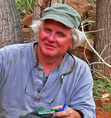Stewart M. Green's Blog, page 3
December 6, 2020
Renaming Mount Evans: Thoughts on the Sand Creek Massacre in 1864
A few days ago, a formal petition was filed by the Cheyenne and Arapaho tribes and The Wilderness Society with the Board of Geographic Names, part of the U.S. Geological Society, to rename 14,271-foot Mount Evans, the 14th highest mountain in Colorado, to Mount Blue Sky, an English-language translation of its tribal name.
The Board is also considering three other new names for the mountain, Mount Cheyenne Arapaho, Mount Soule, and Mount Rosalie. This name change is long overdue and necessary to further the healing of one of the most tragic and ignominious events in Colorado history.
The mountain was named in 1895 to honor Territorial Governor John Evans, a transplanted Illinoisan (Evanston, a Chicago suburb is named for him) who was appointed the second governor by President Lincoln in 1862. Evans, however, was complicit in the horrific Sand Creek Massacre in eastern Colorado. In 1864, Evans, also the region’s Superintendent of Indian Affairs, told residents to take up arms and “all citizens of Colorado ... to go in pursuit of all hostile Indians [and] kill and destroy all enemies of the country.”
Based on that order and with Governor Evan’s blessing, Colonel John Chivington of the Colorado Volunteers marched 675 infantry and cavalry troops to southeastern Colorado, and, despite warnings from other soldiers not to attack the Cheyenne who were negotiating for peace, Chivington’s men attacked a winter village of roughly 500 Southern Cheyenne and Arapaho people in the early morning hours of November 29, 1864.
In eight hours, the troops murdered over 230 people, mostly women, children, and elders, as well as several chiefs, while the others fled on foot, running across the snow-covered, cactus-studded prairie. The soldiers killed indiscriminately, shooting children in the head at point-blank range, cutting breasts and vaginas from still-living women and penises from men, and scalping others.
Two commanders, Captain Silas Soule and Lieutenant Joseph Cramer, didn’t allow their troops to participate in the massacre of innocent people. Holding their men on the bluff above the big bend of Big Sandy Creek, they were unable to stop the slaughter since they too were threatened with death if they intervened.
Testimony later in U.S. government investigations and writings by observers are absolutely horrifying accounts.
“I refused to fire and swore that none but a coward would. Hundreds of women and children were coming towards us and getting on their knees for mercy ... it was hard to see little children ... have their brains beat out by men professing to be civilized.” Captain Silas Soule
“Fingers and ears were cut off the bodies for the jewelry they carried. The body of White Antelope, lying solitarily in the creek bed, was a prime target. Besides scalping him the soldiers cut off his nose, ears, and testicles--the last for a tobacco pouch….” Stan Hoig
“I saw one squaw lying on the bank, whose leg had been broken. A soldier came up to her with a drawn sabre. She raised her arm to protect herself; he struck, breaking her arm. She rolled over, and raised her other arm; he struck, breaking that, and then left her without killing her. I saw one squaw cut open, with an unborn child lying by her side.” Robert Bent
“I saw the bodies of those lying there cut all to pieces, worse mutilated than any I ever saw before; the women cut all to piece... With knives; scalped; their brains knocked out; children two or three months old; all ages lying there, from sucking infants up to warriors ... By whom were they mutilated? By the United States troops...” John S. Smith
I visited the Sand Creek Massacre National Historic Site in far eastern Colorado a month ago and walked the trail along the bluff above the bend of Big Sandy Creek. The last, lingering golden leaves of cottonwoods rustled in the breeze along the dry creek bed and the sun gleamed from a flawless blue sky. It was the kind of autumn day that makes you feel that all is right with the world.
But out there at Sand Creek, I felt anything but all right. It’s a hallowed place with sacred ground, the site of murder, mayhem, and cultural genocide, a place of blood, gore, hatred, and everything that is so ugly in the world. Walking along the bluff, I sensed the cries of anguish, the sobs of the lost souls, the silence of the dead. It’s a moving experience to stand and look across the shallow valley, mostly unchanged since that terrible day 156 years ago. It is a place that every Coloradoan and every American should visit and pay respect to those innocent people that died at the hand, rifle, and knife of the United States government.
A few days ago, on November 29, a small, socially-distanced three-hour ceremony occurred at Sand Creek as it does on that fateful day every year. The descendants of those Cheyenne and Arapaho people that died there gathered to remember the ancestors. The chiefs and tribal members there decided that the new name of Mount Evans should be Mount Blue Sky. Fred Mosqueda, the coordinator of the Culture Program of the Cheyenne and Arapaho tribes, said they could feel their ancestors there. “It was windy. It was tough to get going. We sang the songs, and this feeling came over us. They were happy we still came.”
So, yes, I support renaming that broad-shouldered mountain looming beyond the Denver skyline for the ancestors and for the still-living Cheyenne and Arapaho people. Mount Blue Sky. It’s hopeful and healing. It’s what dominates this land of prairie, peak, and plateau.
We don’t need a mountain name that commemorates and honors a man who urged his fellow citizens to wantonly kill native peoples. We need a reckoning of our history and an understanding of not only the good, but also the evil. We have to stop running from our historical sins to begin the process of healing. We have to remember that this land that we call Colorado, a place of beauty, majesty, raw nature, and a vault of blue sky, is the ancestral homeland of ancient native peoples. They didn’t own this land. They belonged to the land.
Photograph below: Looking west from the summit of 14,471-foot Mount Blue Sky to Mount Bierstadt (left) and 14,265-foot West Blue Sky, an unranked 14er also called West Evans on a stormy August afternoon. Photograph © Stewart M. Green

The Board is also considering three other new names for the mountain, Mount Cheyenne Arapaho, Mount Soule, and Mount Rosalie. This name change is long overdue and necessary to further the healing of one of the most tragic and ignominious events in Colorado history.
The mountain was named in 1895 to honor Territorial Governor John Evans, a transplanted Illinoisan (Evanston, a Chicago suburb is named for him) who was appointed the second governor by President Lincoln in 1862. Evans, however, was complicit in the horrific Sand Creek Massacre in eastern Colorado. In 1864, Evans, also the region’s Superintendent of Indian Affairs, told residents to take up arms and “all citizens of Colorado ... to go in pursuit of all hostile Indians [and] kill and destroy all enemies of the country.”
Based on that order and with Governor Evan’s blessing, Colonel John Chivington of the Colorado Volunteers marched 675 infantry and cavalry troops to southeastern Colorado, and, despite warnings from other soldiers not to attack the Cheyenne who were negotiating for peace, Chivington’s men attacked a winter village of roughly 500 Southern Cheyenne and Arapaho people in the early morning hours of November 29, 1864.
In eight hours, the troops murdered over 230 people, mostly women, children, and elders, as well as several chiefs, while the others fled on foot, running across the snow-covered, cactus-studded prairie. The soldiers killed indiscriminately, shooting children in the head at point-blank range, cutting breasts and vaginas from still-living women and penises from men, and scalping others.
Two commanders, Captain Silas Soule and Lieutenant Joseph Cramer, didn’t allow their troops to participate in the massacre of innocent people. Holding their men on the bluff above the big bend of Big Sandy Creek, they were unable to stop the slaughter since they too were threatened with death if they intervened.
Testimony later in U.S. government investigations and writings by observers are absolutely horrifying accounts.
“I refused to fire and swore that none but a coward would. Hundreds of women and children were coming towards us and getting on their knees for mercy ... it was hard to see little children ... have their brains beat out by men professing to be civilized.” Captain Silas Soule
“Fingers and ears were cut off the bodies for the jewelry they carried. The body of White Antelope, lying solitarily in the creek bed, was a prime target. Besides scalping him the soldiers cut off his nose, ears, and testicles--the last for a tobacco pouch….” Stan Hoig
“I saw one squaw lying on the bank, whose leg had been broken. A soldier came up to her with a drawn sabre. She raised her arm to protect herself; he struck, breaking her arm. She rolled over, and raised her other arm; he struck, breaking that, and then left her without killing her. I saw one squaw cut open, with an unborn child lying by her side.” Robert Bent
“I saw the bodies of those lying there cut all to pieces, worse mutilated than any I ever saw before; the women cut all to piece... With knives; scalped; their brains knocked out; children two or three months old; all ages lying there, from sucking infants up to warriors ... By whom were they mutilated? By the United States troops...” John S. Smith
I visited the Sand Creek Massacre National Historic Site in far eastern Colorado a month ago and walked the trail along the bluff above the bend of Big Sandy Creek. The last, lingering golden leaves of cottonwoods rustled in the breeze along the dry creek bed and the sun gleamed from a flawless blue sky. It was the kind of autumn day that makes you feel that all is right with the world.
But out there at Sand Creek, I felt anything but all right. It’s a hallowed place with sacred ground, the site of murder, mayhem, and cultural genocide, a place of blood, gore, hatred, and everything that is so ugly in the world. Walking along the bluff, I sensed the cries of anguish, the sobs of the lost souls, the silence of the dead. It’s a moving experience to stand and look across the shallow valley, mostly unchanged since that terrible day 156 years ago. It is a place that every Coloradoan and every American should visit and pay respect to those innocent people that died at the hand, rifle, and knife of the United States government.
A few days ago, on November 29, a small, socially-distanced three-hour ceremony occurred at Sand Creek as it does on that fateful day every year. The descendants of those Cheyenne and Arapaho people that died there gathered to remember the ancestors. The chiefs and tribal members there decided that the new name of Mount Evans should be Mount Blue Sky. Fred Mosqueda, the coordinator of the Culture Program of the Cheyenne and Arapaho tribes, said they could feel their ancestors there. “It was windy. It was tough to get going. We sang the songs, and this feeling came over us. They were happy we still came.”
So, yes, I support renaming that broad-shouldered mountain looming beyond the Denver skyline for the ancestors and for the still-living Cheyenne and Arapaho people. Mount Blue Sky. It’s hopeful and healing. It’s what dominates this land of prairie, peak, and plateau.
We don’t need a mountain name that commemorates and honors a man who urged his fellow citizens to wantonly kill native peoples. We need a reckoning of our history and an understanding of not only the good, but also the evil. We have to stop running from our historical sins to begin the process of healing. We have to remember that this land that we call Colorado, a place of beauty, majesty, raw nature, and a vault of blue sky, is the ancestral homeland of ancient native peoples. They didn’t own this land. They belonged to the land.
Photograph below: Looking west from the summit of 14,471-foot Mount Blue Sky to Mount Bierstadt (left) and 14,265-foot West Blue Sky, an unranked 14er also called West Evans on a stormy August afternoon. Photograph © Stewart M. Green

Published on December 06, 2020 11:05
November 26, 2020
Thoughts on a Pandemic Thanksgiving Day
 A double rainbow arcs across the evening sky above the Colorado Springs skyline, Photograph © Stewart M. GreenWe’re thankful on Thanksgiving Day for life and the bounty of the world. We’re thankful for family and friends and feast, gathered around the dining room table and later, the kitchen sink washing and drying tottering piles of dishes.
A double rainbow arcs across the evening sky above the Colorado Springs skyline, Photograph © Stewart M. GreenWe’re thankful on Thanksgiving Day for life and the bounty of the world. We’re thankful for family and friends and feast, gathered around the dining room table and later, the kitchen sink washing and drying tottering piles of dishes. This pandemic year is different though. I’m not doing anything, nothing, nada, nil. Socially distanced, no heaped plates, no friends, no family, no sip of wine, no vegan roast, no lively conversations, no family squabbles. Instead, I am finishing a chapter for a book this morning and then heading west to Elevenmile Canyon in the mountains to spend the afternoon shooting photographs, hiking up obscure rocky summits, basking in winter sunshine, and being alone amid natural splendor.
That feels right to me this November.
But yes, there is much to celebrate this year, despite the brutal death toll from the pandemic, the deaths of my mother and friends, the loss of friendships, and a self-imposed isolation to stay well and healthy. I celebrate the season with day-to-day happiness, with the grounding that my work gives me, and with therapeutic changes in my life that help me understand my past motivations and dishonest actions and help me continue on the life-long journey of self-awareness, personal growth, and individuation.
We want these days of 2020, the year of pandemic, death, isolation, panic, and crazy politics, to be over, to be forgotten, to be relegated to the trash bin with the broken crockery and old ways. We want a new dawn breaking, a return to normal, a new normal, even a better abnormal. And perhaps that new normal is lingering on the still bleak horizon of 2021 with promises of vaccines and herd immunity and a return to eating at our favorite restaurants and socializing with friends and shedding masks so we can again see each other’s smiles and frowns.
Perhaps those days will come. But until that sun rises on a new day, we are making the best of this year and are grateful for moments of happiness, kind words, selfless actions, and being part of this spinning merry-go-round on our pet ponies.
Give thanks, my friends, rejoice and be grateful. I am.
I shot the photograph of a double rainbow on a summer's evening as the day's last light shafted over Pikes Peak, illuminating a flotilla of gauzy clouds with shades of orange.
Published on November 26, 2020 17:19
November 24, 2020
Coolest Colorado Building: US Olympic & Paralympic Museum
Colorado Springs, home of the big box building, is now home to one of the coolest new buildings in the United States—the U.S. Olympic & Paralympic Museum.
The sleek building, celebrating the Olympic athlete, twists and stretches pinwheel-like around a central three-story atrium with radiating galleries filled with Olympic memorabilia and interactive exhibits. The exterior is stunning with thousands of diamond-shaped satin aluminum panels that shimmer in the moving sunlight.
The building, rising southwest of the downtown boxes, sits alongside the railroad tracks. A futuristic bridge, still under construction, will connect the museum to America the Beautiful Park to the west.
I haven’t been to the museum yet. It’s kind of pricey and my usual museum companion isn’t available, so I may have to go alone and check it out this month.
I’ve always been an Olympic junkie and can’t wait to check out the exhibits like the scoreboard from the Lake Placid Olympics in 1980 when Team USA dumped the Soviet hockey machine and then went on to win the gold medal game against Finland.
I shot this photograph of the gleaming building on a sunny afternoon a few days ago in mid-November.
Buildings in downtown Colorado Springs etch the horizon beyond the Olympic and Paralympic Museum. Photograph © Stewart M. Green
The sleek building, celebrating the Olympic athlete, twists and stretches pinwheel-like around a central three-story atrium with radiating galleries filled with Olympic memorabilia and interactive exhibits. The exterior is stunning with thousands of diamond-shaped satin aluminum panels that shimmer in the moving sunlight.
The building, rising southwest of the downtown boxes, sits alongside the railroad tracks. A futuristic bridge, still under construction, will connect the museum to America the Beautiful Park to the west.
I haven’t been to the museum yet. It’s kind of pricey and my usual museum companion isn’t available, so I may have to go alone and check it out this month.
I’ve always been an Olympic junkie and can’t wait to check out the exhibits like the scoreboard from the Lake Placid Olympics in 1980 when Team USA dumped the Soviet hockey machine and then went on to win the gold medal game against Finland.
I shot this photograph of the gleaming building on a sunny afternoon a few days ago in mid-November.
Buildings in downtown Colorado Springs etch the horizon beyond the Olympic and Paralympic Museum. Photograph © Stewart M. Green

Published on November 24, 2020 16:29
November 21, 2020
Hiking Up Pulpit Rock in Colorado Springs
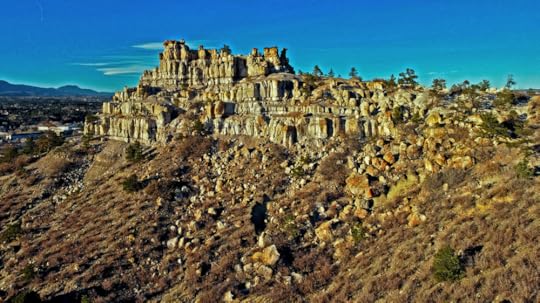 Pulpit Rock's jagged, rocky skyline is a prominent landmark in northern Colorado Springs. Photograph © Stewart M. Green
Pulpit Rock's jagged, rocky skyline is a prominent landmark in northern Colorado Springs. Photograph © Stewart M. GreenDuring this year of pandemic, sorrow, upheaval, and isolation, I've been getting out every day to hike local trails and climb at a few remote cliffs. I have a few trails that scramble to low summits where I see few to no people, which is perfect. According to my list, this year I've tagged 251 mountain summits so 49 to climb for an even 300. I think I'm going to make it.
A few days ago, however, I decided to hike up 6,610-foot Pulpit Rock, a local Colorado Springs landmark that towers above North Nevada Avenue and I-25, and shoot some photographs. The unranked summit, reached by a mile-long hike on various social trails, offers perhaps the best view of Pikes Peak and its satellite mountains in the Springs.
Unfortunately, Pulpit Rock, once an isolated refuge, is now a popular hike since the University of Colorado at Colorado Springs built dorms below it so students are often lizard-lounging on ledges below the rocky top. Today, I decided I needed to risk the ascent in this pandemic year, so I donned my tiger-face mask when I got to the top and scrambled onto the small summit for only a minute since two kids were already up there.
After leaving the top, I followed another old trail along a couple of ridges and dropped down to the isolated sandstone summit of Eagle Rock just as the sun dipped behind Pikes Peak's south shoulder at 4:16 in the late afternoon. The best thing was that no one else was within a half-mile of me.
Pulpit Rock, formed by a coarse sedimentary rock called Dawson arkose deposited along the eastern edge of the early Rocky Mountains, lies at the northern end of Austin Bluffs Open Space, which includes a series of eroded bluffs to the southeast. The area is still mostly undeveloped with only eroded social trails climbing the peaks and threading through grassy valleys.
To hike Pulpit Rock, which is in my new BEST HIKES COLORADO SPRINGS book, I usually park at a trailhead by a utility station off North Nevada and then follow a good trail south until I'm below Pulpit and finish up a steep social trail on the peak's north flank. Alternatively, I sometimes park at the big lot for the UCCS Field House and work up social trails from there.
Buy BEST HIKES COLORADO SPRINGS.
Published on November 21, 2020 09:31
November 13, 2020
John Gill: The Master of Rock Speaks
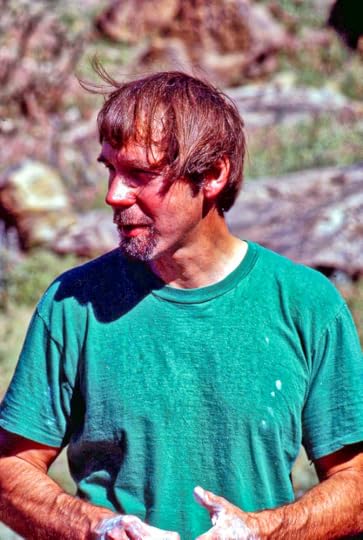 Photograph above: John Gill talks about bouldering in remote Lost Canyon southeast of Pueblo, Colorado. Photograph © Stewart M. GreenThe other day I ferreted out my article notes from a detailed interview I did with John Gill, who was 41 years old at the time, in July 1979 at his home in Pueblo. John, as anyone who has climbed much knows, is rightly considered as the founder of the discipline of modern bouldering, the art of climbing difficult problems on small rocks, blocks, and boulders.
Photograph above: John Gill talks about bouldering in remote Lost Canyon southeast of Pueblo, Colorado. Photograph © Stewart M. GreenThe other day I ferreted out my article notes from a detailed interview I did with John Gill, who was 41 years old at the time, in July 1979 at his home in Pueblo. John, as anyone who has climbed much knows, is rightly considered as the founder of the discipline of modern bouldering, the art of climbing difficult problems on small rocks, blocks, and boulders. For many of my climbing days, I considered myself a boulderer, partly because of John's thoughts about bouldering. I liked to head up in the hills above Colorado Springs or wherever I was and find problems on boulders. Some were easy. Some were hard. Some I couldn't do without months of work to dial in the right sequence.
In those days I preferred bouldering because I liked climbing alone, without chatter or distraction. Bouldering was a type of vertical meditation and it was simple. Just me and the rock, and, of course, a pair of rock shoes, RDs, PAs, EBs, Coonyards, Fires. Plus, it always seemed silly to give names and ratings and such to a 12-foot face that was climbed in a half-dozen hand and foot movements.
Anyway, Mr. Gill's approach to climbing and bouldering matched up with mine. I always felt honored to watch and photograph the master of the boulders at play. Here are a few quotes from that interview:
"The boulderer and the rock climber search for the same basic type of climb, but the boulderer has learned to think small. They both seek hard lines on clean expanses of rock, but the boulder specialist will probably be a little disappointed if he solves his problem too quickly."
"It's not really a sport. It's a climbing activity with metaphysical, mystical, and philosophical overtones."
"As I became a better boulderer I began feeling something which I didn't name until a few years ago. For lack of better words, I call it 'kinesthetic awareness.' It describes a graceful, artistic motion. I feel it when I am climbing balanced and smooth. The more you do it the smoother you become and the more this feeling is allowed to emerge."
"Bouldering is a vertical path to increased awareness."
"Bouldering enhances the other parts of my life in the sense that after the intense involvement of bouldering I can come away from it relaxed and with a sense of relief."
"I still feel I am at a frontier of bouldering but not necessarily of difficulty. Now I am going into another frontier--you can call it mystical or spiritual."
I shot the portrait of John Gill in July 1979 at the base of the Penny Ante Boulder along the Huerfano River in remote Lost Canyon southeast of Pueblo, Colorado.
I shot the other image of John bouldering at age 70 in a canyon west of Lake Pueblo in April 2005. Eric Horst and I visited with John at his home in Pueblo West (Eric interviewed John for a climbing CD) and then we headed over to Little Owl Canyon where we met up with Colin Lantz.
Photograph below: John Gill bouldering in Little Owl Canyon near his home in Pueblo West, Colorado, in 2005. Photograph © Stewart M. Green
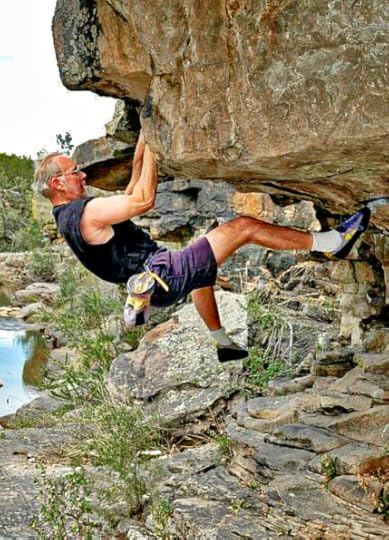
Published on November 13, 2020 13:32
November 7, 2020
Time Stands Still at Indian Creek Canyon
Here's a short essay that I wrote In September 2003 about Indian Creek Canyon for an Indian Creek climbing guidebook that Sharpend Books published. I was digging through some files this afternoon, found it, and thought it was worth another read.
I shot the two photographs of the first ascent of Supercrack in early November 1976. These are scanned color prints made from scans from the original Kodachrome transparencies that are signed by some of my friends that were at the Creek on that momentous day--Ed Webster, Bryan Becker, Jimmie Dunn, and me, as well as Chris Alstrin who made the film Luxury Liner about Supercrack in 2008.
I have a limited number of signed copies of the photos for sale. For more info and pricing, send me a note at stewartmgreen@gmail.com
Here is the essay:
Indian Creek. To me, there has always been magic in that name. That sinuous canyon, lined with soaring walls of ruddy Wingate sandstone, is a special place. A place not just for climbing adventures, but a place to connect with the elemental earth and with the ancient ones who once hid in aeries tucked into the cliffs and scribed their art on desert varnished panels.
The first time I saw Indian Creek was in late November 1971. Jim Dunn, Billy Westbay, and I drove down the remote canyon in my white VW bug, en route to an early ascent of North Sixshooter Peak. That sunny first afternoon we stopped and scrambled up to the base of several buttresses. The most prominent one towered above the road and cattle guard. We walked along the cliff-base until we reached the most perfect crack we had ever seen. We dubbed it “The Supercrack” and longed to sink our hands into its perfection. But neither bong pitons nor our largest Colorado nuts, a new passive technology that lessened rock damage, could safely protect the parallel-sided slit.
In October, five years and many trips later to Indian Creek and our favorite campsite at Fringe of Death Canyon, I returned to Supercrack. Earl Wiggins, his wife Cheryl, and dog O’Thing, and I had caravanned over from Colorado, while Jim had driven west from New Hampshire towing Ed Webster and Bryan Becker. The following day Earl and Jim had a date with Supercrack.
I was to photograph and film the ascent. But Jim elected not to climb, the “vibes weren‘t right,” so Earl, belayed by Webster, jammed his way up the perfect crack toward a vault of azure sky. I recorded it all for posterity on Kodachrome, Super 8 film, and audiotapes. In my mind, that day was the start of modern crack climbing at Indian Creek—the best crack area in the world.
Over the years I’ve continued to sojourn to Indian Creek, but somewhere along the way I found there were just too many folks there. The cracks were getting worn on the edges and all chalked up. Trails crisscrossed the talus slopes. Toilet tissue flowers sprouted on clumps of sagebrush. Dogs ran everywhere with abandon. People came to climb, but many didn’t care enough about the place, its beauty, and its uniqueness.
That seems to be changing, for the better. So now I come to Indian Creek in the off-season when few other climbers are about. The resolute cliffs still wall the canyon’s sides. The fractured cracks still cleave the sculptured sandstone. The ravens still fly on errands through the cottonwoods. The rock and sandy soil still smells dry and dusty under the hot sun. Times change, yes. But time also stands still. At Indian Creek.
Photograph captions:
Left photo: Earl Wiggins jams the first section of the perfect crack on a cloudless November day in 1976. Photograph © Stewart M. Green
Right Photo: Earl Wiggins belays Ed Webster on the first pitch of Supercrack in November 1976. Photograph © Stewart M. Green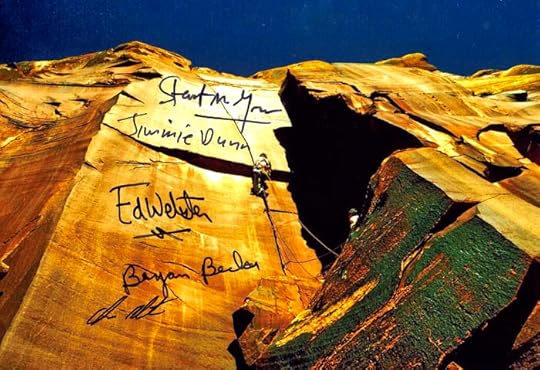
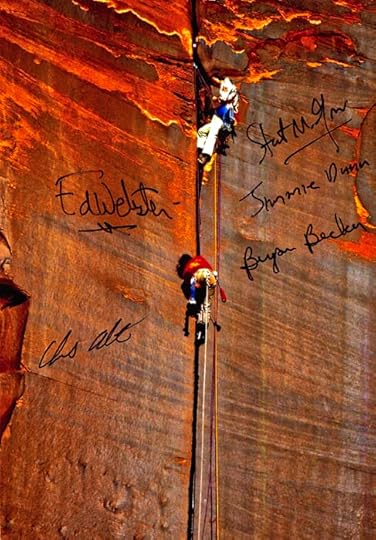
I shot the two photographs of the first ascent of Supercrack in early November 1976. These are scanned color prints made from scans from the original Kodachrome transparencies that are signed by some of my friends that were at the Creek on that momentous day--Ed Webster, Bryan Becker, Jimmie Dunn, and me, as well as Chris Alstrin who made the film Luxury Liner about Supercrack in 2008.
I have a limited number of signed copies of the photos for sale. For more info and pricing, send me a note at stewartmgreen@gmail.com
Here is the essay:
Indian Creek. To me, there has always been magic in that name. That sinuous canyon, lined with soaring walls of ruddy Wingate sandstone, is a special place. A place not just for climbing adventures, but a place to connect with the elemental earth and with the ancient ones who once hid in aeries tucked into the cliffs and scribed their art on desert varnished panels.
The first time I saw Indian Creek was in late November 1971. Jim Dunn, Billy Westbay, and I drove down the remote canyon in my white VW bug, en route to an early ascent of North Sixshooter Peak. That sunny first afternoon we stopped and scrambled up to the base of several buttresses. The most prominent one towered above the road and cattle guard. We walked along the cliff-base until we reached the most perfect crack we had ever seen. We dubbed it “The Supercrack” and longed to sink our hands into its perfection. But neither bong pitons nor our largest Colorado nuts, a new passive technology that lessened rock damage, could safely protect the parallel-sided slit.
In October, five years and many trips later to Indian Creek and our favorite campsite at Fringe of Death Canyon, I returned to Supercrack. Earl Wiggins, his wife Cheryl, and dog O’Thing, and I had caravanned over from Colorado, while Jim had driven west from New Hampshire towing Ed Webster and Bryan Becker. The following day Earl and Jim had a date with Supercrack.
I was to photograph and film the ascent. But Jim elected not to climb, the “vibes weren‘t right,” so Earl, belayed by Webster, jammed his way up the perfect crack toward a vault of azure sky. I recorded it all for posterity on Kodachrome, Super 8 film, and audiotapes. In my mind, that day was the start of modern crack climbing at Indian Creek—the best crack area in the world.
Over the years I’ve continued to sojourn to Indian Creek, but somewhere along the way I found there were just too many folks there. The cracks were getting worn on the edges and all chalked up. Trails crisscrossed the talus slopes. Toilet tissue flowers sprouted on clumps of sagebrush. Dogs ran everywhere with abandon. People came to climb, but many didn’t care enough about the place, its beauty, and its uniqueness.
That seems to be changing, for the better. So now I come to Indian Creek in the off-season when few other climbers are about. The resolute cliffs still wall the canyon’s sides. The fractured cracks still cleave the sculptured sandstone. The ravens still fly on errands through the cottonwoods. The rock and sandy soil still smells dry and dusty under the hot sun. Times change, yes. But time also stands still. At Indian Creek.
Photograph captions:
Left photo: Earl Wiggins jams the first section of the perfect crack on a cloudless November day in 1976. Photograph © Stewart M. Green
Right Photo: Earl Wiggins belays Ed Webster on the first pitch of Supercrack in November 1976. Photograph © Stewart M. Green


Published on November 07, 2020 11:21
November 4, 2020
The Hills were Alive with the Sound of Music: Photo of the Da Vinci Quartet in 1982
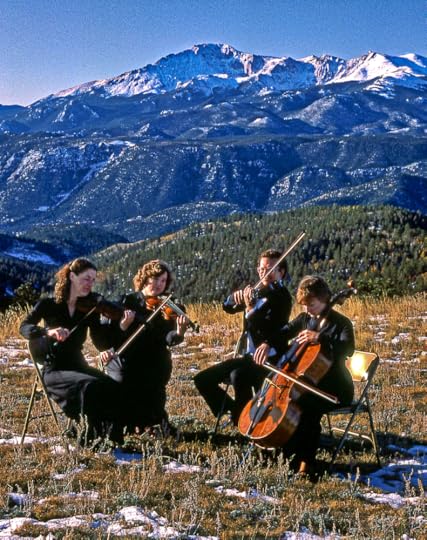 The hills were alive with the sound of music! The Da Vinci Quartet played a Beethoven string quartet atop the Rampart Range below Pikes Peak for my camera in late October 1982. Photograph © Stewart M. GreenThis is a photograph that I shot of the Da Vinci Quartet in late October 1982 for the cover of a local magazine in Colorado Springs.
The hills were alive with the sound of music! The Da Vinci Quartet played a Beethoven string quartet atop the Rampart Range below Pikes Peak for my camera in late October 1982. Photograph © Stewart M. GreenThis is a photograph that I shot of the Da Vinci Quartet in late October 1982 for the cover of a local magazine in Colorado Springs. The quartet’s premiere Colorado Springs performance was at 3:00 p.m. on November 21 that year at the Fine Arts Center. A chamber music quartet includes two violins, a viola, and a cello. The Da Vinci’s four accomplished classical musicians at the start were Jerilyn Jorgensen, Renee Tegel, Katharine Knight, and Matthew Michelic. The quartet was sponsored by the Colorado Springs Symphony.
The musicians were good sports to haul themselves and their instruments up Ute Pass to a 9.000-foot-high meadow off the Rampart Range Road on a cold, early morning a few days after a snowfall.
I carried their folding chairs and a bag of Canon cameras and lenses a couple hundred yards to my chosen spot for the shoot. They sat down and commenced playing while I picked the moments to record for posterity. Besides being outside in fresh air and surrounded by stunning views, the spirited and joyful music was unforgettably fantastic too.
The quartet, with different members of the ensemble, continued thrilling audiences, recording albums, appeared on PBS in 1998, fostered musical outreach programs, taught music in universities and colleges, and performed the complete cycle of Beethoven’s amazing string quartets until disbanding in the 2000s.
Published on November 04, 2020 08:43
November 2, 2020
NEW RELEASE! Best Hikes Colorado Springs is on the Shelf
Today, November 2, marks the official release of the new 2nd edition of my book
BEST HIKES COLORADO SPRINGS
!
It's a gorgeous guide to all the best hikes around Colorado Springs at the Garden of the Gods, on Pikes Peak, Calhan Paint Mines, North Cheyenne Canon, and lots of other footpaths, with maps, directions, interpretive info, and color photographs.
I'm excited because this is my third book to come out this year! The others are Best Hikes Albuquerque and Climbing Pikes Peak , which is another local bestseller. BEST HIKES COLORADO SPRINGS was scheduled for release on May 1 but due to the pandemic, its printing and release were delayed until now, making it a perfect holiday gift.
As of today, it's listed as the #1 New Release in Colorado Travel Guides on Amazon! Woohoo! If you snag a copy, write me a review there and I can arrange to sign it.
Walk on, friends. Follow a footpath for adventure, beauty, and health. See you on the trail.
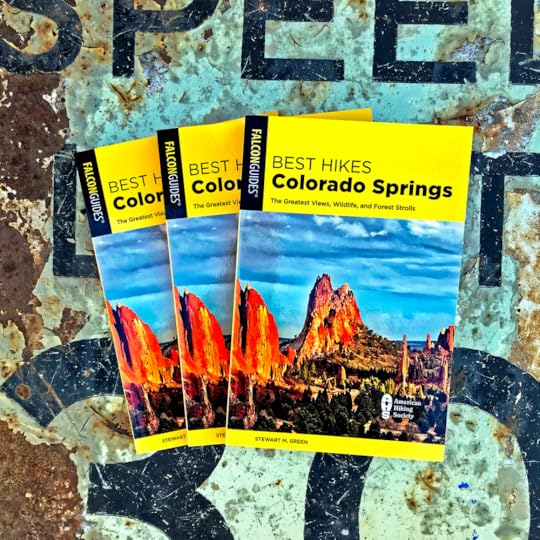
It's a gorgeous guide to all the best hikes around Colorado Springs at the Garden of the Gods, on Pikes Peak, Calhan Paint Mines, North Cheyenne Canon, and lots of other footpaths, with maps, directions, interpretive info, and color photographs.
I'm excited because this is my third book to come out this year! The others are Best Hikes Albuquerque and Climbing Pikes Peak , which is another local bestseller. BEST HIKES COLORADO SPRINGS was scheduled for release on May 1 but due to the pandemic, its printing and release were delayed until now, making it a perfect holiday gift.
As of today, it's listed as the #1 New Release in Colorado Travel Guides on Amazon! Woohoo! If you snag a copy, write me a review there and I can arrange to sign it.
Walk on, friends. Follow a footpath for adventure, beauty, and health. See you on the trail.

Published on November 02, 2020 12:29
October 30, 2020
Penitente Canyon: A Climbing Ghost Story
 Photograph: Ian Green climbing the route A Virgin No More next to the Virgin Mary folk painting in Penitente Canyon in southern Colorado in 1998. Photo ,© Stewart M. GreenWhat is our pagan holiday Samhain without a good spook story? This is the time of year, after the harvest and before the deathly chill of winter, that the veil between this world and the next grows thin and the spirits leak into our human reality.
Photograph: Ian Green climbing the route A Virgin No More next to the Virgin Mary folk painting in Penitente Canyon in southern Colorado in 1998. Photo ,© Stewart M. GreenWhat is our pagan holiday Samhain without a good spook story? This is the time of year, after the harvest and before the deathly chill of winter, that the veil between this world and the next grows thin and the spirits leak into our human reality.Climbers spend a lot of time outside at strange and weird places with names like Devil’s Lake, Devil’s Den, Ghost River Valley, Witch’s Canyon, and Spook Canyon. Some live up to their name with odd events randomly occurring. Of course, climbers die out there on mountains and cliffs and some probably haunt the site of their demise, their spirits bound to the earth with climbing rope, chains of slings, and clanking nuts on their spectral harnesses.
I’ve had a few bizarre and unexplained encounters on climbing trips: devil winds in Colorado’s San Juan Mountains, a UFO sighting near Hueco Tanks, a shaman’s apparition at a remote pictograph panel near the Grand Canyon, a bundle of willow sticks bound with twine outside my tent near Stonehenge, and an eerie encounter with a twilight dweller in Penitente Canyon, an old place on the western edge of the San Luis Valley that was home for millennia to early paleo-hunters.
These early Americans lived among the volcanic cliffs on the edge of a huge lake, hunting plentiful game and catching fish. Evidence of their passage remains in white flint projectile points found in hollows above the cliffs and buried charcoal from ancient campfires. The canyon was undoubtedly a sacred place to those native peoples.
The canyon was also holy to a group of Penitente brothers, a Catholic sect that practices self-flagellation or whipping and a mock crucifixion of a member every Easter, who established a Morada or meeting house in the canyon. On one clean wall, a member painted the visage of the Virgin Mary.
The San Luis Valley itself is renowned as one of Colorado’s most haunted places with glimpses of ghostly cowboys occasionally seen on sagebrush plains, strange and baffling cattle mutilations, and regular UFO and Bigfoot sightings.
My Penitente nocturnal event occurred in early November 1992, a few days after Halloween. I was camping alone at the Penitente campground, then at the canyon mouth, waiting to meet up with a couple friends to climb the next day.
That evening after sunset, I walked up the canyon trail to the Virgin painting, decorating the cliff 40 feet above the ground, and climbed onto a high sloping boulder below it. I sat for a long time watching the painting in the faint glint of light from a crescent moon hanging above the western canyon rim.
After the sliver of the moon set behind the inky canyon walls,
I started to climb down the boulder but stopped when I heard a distant shrill cry like a wounded animal. Immediately the hair on the nape of my neck stood on end and gooseflesh shivered my arm. Thickets of scrub oak just up the canyon began shaking like a large animal was pushing through them. I stood still, senses alert, unmoving. The movement stopped and the world was again still and silent. I shined a light up the canyon and saw nothing but bare scrub oak branches. It’s just your imagination, I thought. Get a grip.
Suddenly a wind rushed down the canyon and what felt like a cold hand grasped my shoulder. I twisted and jumped from the boulder and fled down the trail. Not stopping. Not looking back. At the campsite, I opened my truck door, climbed inside, and locked the door. The wind shook the truck, lecherously rocking it back and forth.
An hour later the gale briefly subsided so I turned on my headlamp and crept from the truck to grab my sleeping bag from the tent. I locked myself back in the cab and slept fitfully until daybreak.
Published on October 30, 2020 15:22
October 28, 2020
Journalism Gives a View into Other Lives Like Rancher Tom Lasater
 Rancher Tom Lasater gives a treat to one of his prize Beefmaster bulls near Matheson, Colorado in August 1982. Photograph © Stewart M. GreenI've spent most of my adult life telling stories with words and images, except for a few misspent years hauling bricks, mixing mortar, building scaffolds, and being a general layabout climbing bum. My work, although I hardly call it work since it's pleasurable, has been as a journalist, photojournalist, and nonfiction writer of travel and adventure travel books and articles.
Rancher Tom Lasater gives a treat to one of his prize Beefmaster bulls near Matheson, Colorado in August 1982. Photograph © Stewart M. GreenI've spent most of my adult life telling stories with words and images, except for a few misspent years hauling bricks, mixing mortar, building scaffolds, and being a general layabout climbing bum. My work, although I hardly call it work since it's pleasurable, has been as a journalist, photojournalist, and nonfiction writer of travel and adventure travel books and articles. Being a journalist has given me a lot of great adventures and I've met, talked with, and photographed so many interesting people. Being a journalist gives you a voyeur's license to look at and into other lives and times and places. It's a privilege and honor to be part of what is now dubbed "Fake News."
This is a photograph I shot in August 1982 on a magazine assignment about the ranching life in eastern Colorado. I spent the afternoon with 71-year-old Tom Lasater, a witty, sharp-tongued ranchman who ran cattle on a 28,000-acre parcel east of Colorado Springs near Matheson, just beyond the encroaching suburbs.
I shot this image of Mister Lasater giving a treat to one of his prized Beefmaster cows, a breed that he developed and patented. The breed began when his father Edward began a project of cross-breeding Brahman, Hereford, and shorthorn cattle on a 400,000-acre ranch in Texas in the 1910s and 1920s. After Edward died in 1930, Tom left Princeton and perfected the new breed in 1937, not introducing new genes and "closing the herd."
Tom was proud of the Beefmaster, telling me, "It's the most efficient animal on which you'll find the greatest quantity of lean meat per total pound." Rather than selling his beef the traditional way, Lasater sold it mail order, ensuring a steady customer base.
Taking a puff on a cigarette in a black holder, he continued, "We're the Sears Roebuck of the cattle business, the only successful ranch to do this. When I first came up with this idea I asked all the old-time ranches what they thought and none of them liked it so I knew it would be a success."
Later that afternoon he said, "This is my life on this planet and once I'm gone if my heirs want to turn these cattle into hamburger, I won't give a damn. The important thing is that while we're here, we give it hell."
One last Lasater tidbit. The fellow who came out with me to the ranch was trying to shut one of the ranch gates while Tom and I talked in the Suburban. He couldn't get it closed. Tom watched him, then snarled, "Damn city boy, can't close a goddamn gate!"
So he got out and did it himself.
Published on October 28, 2020 14:37

